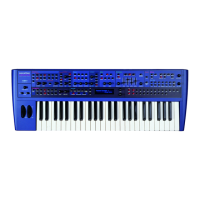MODE SECTION
An Arpeggio must have its Real-time transpose parameter (set in the Arpeggiator Menu) set to On for real-time transposition to
take effect.
Whenever realtime transpose note data is received via MIDI or generated from the keyboard, the Transpose Zone button will blink
briefly.
To write any changes to this parameter into memory press the “Write” button while in this mode. Also note the “Memory Protect”
has to be set to “Off” for this to be possible.
Page 7 looks like so:
The higher parameter is “Local Control”. In this case with a value of On.
This parameter is normally set to On. With this setting, any knob movements or button presses on the front panel are transmitted
via MIDI & also control the synth engine directly. i.e. turning a knob will alter the sound produced regardless of any MIDI setup. If
this parameter is set to Off, knob movements & button presses on the front panel still transmit MIDI data but make no alteration to
the sound. This is the best way to use the Supernova II Rack with a sequencer as all the Channel re - mapping features in
sequencers can be taken fully advantage of. This parameter is memorised as Global.
If there is no MIDI feedback loop connected at all ( a sequencer with MIDI out of the Supernova II Rack connected to MIDI in on
the sequencer & MIDI out of the sequencer connected to MIDI in on the Supernova II Rack for example ) & local control is set to
off, the knobs & buttons on the front panel will appear to do nothing although changing parameters values may be displayed on the
display.
When changing Programs or Performances with the Local off & no MIDI loop present the display will indicate any change made on
the keypad section but will not change the name of the sound. This is because the Supernova II Rack is indicating that a change
has been transmitted with the numbers but this message has not been received & therefore the sound & it’s name has not
changed.
If local control is set to off, When Parts are muted or soloed in Performance mode, flashing Part buttons will indicate the MIDI infor-
mation transmitted, not necessarily relevant to each Parts current mute status.
The lower parameter is “Memory protect”. In this case with a value of Off.
This parameter determines if the memory can be written to or not. Use the lower Data knob to adjust this parameter. In the “On”
position, Programs, Performances, Patterns or Global Data cannot be written into memory. In the “Off” position, Programs,
Performances, Patterns or Global Data can be written into memory. This parameter is memorised as Global.
Page 8 looks like so:
Restore from ROM:
One program

